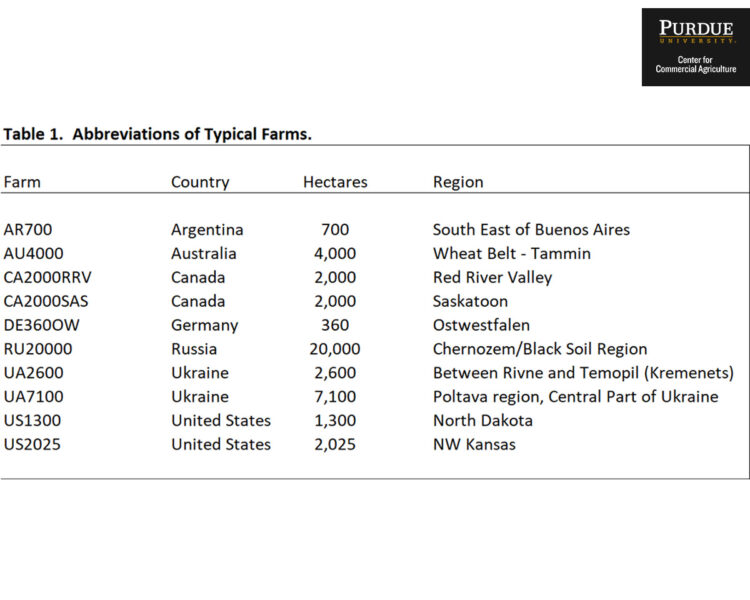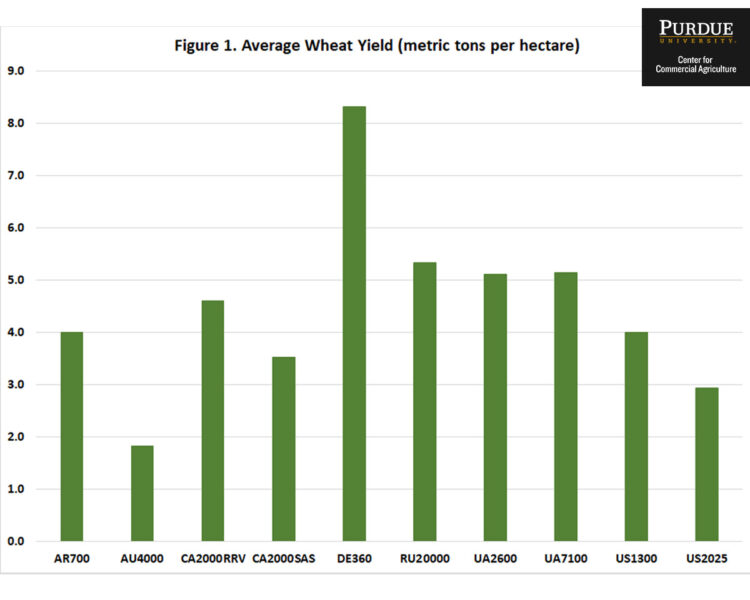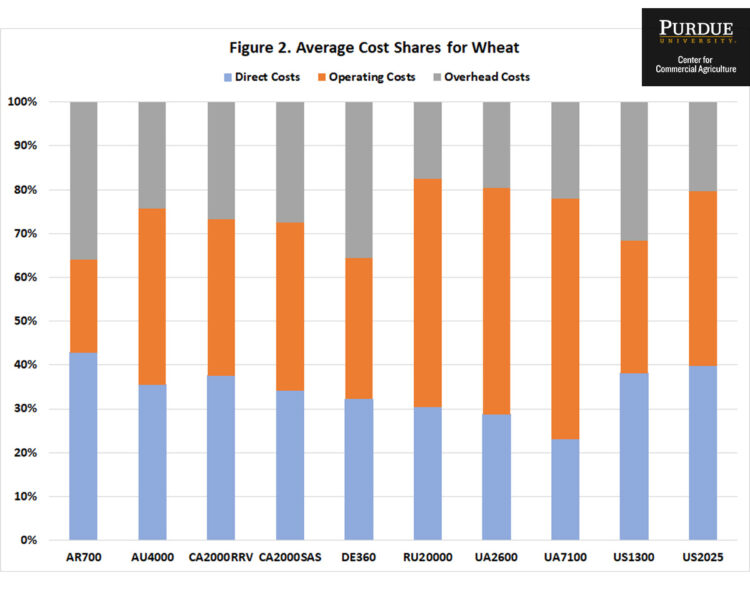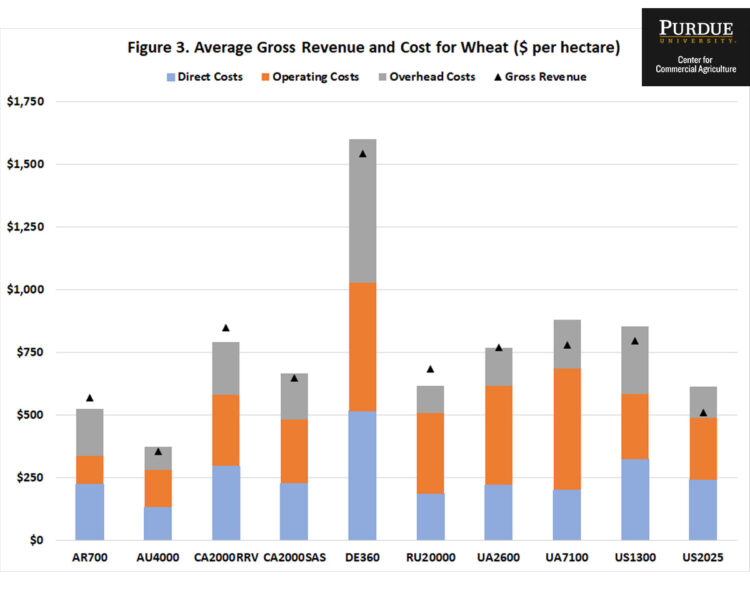May 5, 2022
International Benchmarks for Wheat Production (2022)
by Michael Langemeier and Leying Zhou
Examining the competitiveness of wheat production in different regions of the world is often difficult due to lack of comparable data and agreement regarding what needs to be measured. To be useful, international data needs to be expressed in common production units and converted to a common currency. Also, production and cost measures need to be consistently defined across production regions or farms.
This paper examines the competitiveness of wheat production for important international wheat production regions using 2016 to 2020 data from the agri benchmark network. An earlier paper examined international benchmarks for the 2015 to 2019 period (Langemeier, 2021). The agri benchmark network collects data on beef, cash crops, dairy, pigs and poultry, horticulture, and organic products. There are 21 countries with wheat data for 2020 represented in the cash crop network. The agri benchmark concept of typical farms was developed to understand and compare current farm production systems around the world. Participant countries follow a standard procedure to create typical farms that are representative of national farm output shares, and categorized by production system or combination of enterprises and structural features. Costs and revenues are converted to U.S. dollars so that comparisons can be readily made. Data from ten typical farms with wheat enterprise data from Argentina, Australia, Canada, Germany, Russia, Ukraine, and United States were used in this paper. It is important to note that wheat enterprise data is collected from other countries. These seven countries were selected to simplify the illustration and discussion.
The farm and country abbreviations used in this paper are listed in table 1. All of the farms had data for each year from 2016 to 2020. While the farms may produce a variety of crops, this paper only considers wheat production. Typical farms used in the agri benchmark network are defined using country initials and hectares on the farm. To fully understand the relative importance of the wheat enterprise on each typical farm, it is useful to note all of the crops produced. The typical farm in Argentina produced corn, soybeans, sunflowers, winter barley, and winter wheat in 2020. Wheat was produced on approximately 43 percent of the typical farm’s acreage during the five-year period. The typical farm in Australia produced malting barley, pasture, winter rapeseed, and summer wheat. Wheat was produced on approximately 41 percent of the typical farm’s acreage. The Canadian farm in the Red River Valley produced corn, summer rapeseed, soybeans, and summer wheat with wheat representing 26 percent of the farm’s acreage during the five-year period. The typical farm in Saskatoon produced summer rapeseed, peas, and summer wheat with wheat representing approximately 43 percent of the farm’s acreage during the five-year period. The German farm produced winter barley, sugar beets, corn silage, winter rapeseed, and winter wheat. During the five-year period, wheat was planted on 53 percent of the typical farm’s acreage. The farm in Russia produced alfalfa, summer barley, chickpeas, corn, corn silage, fodder grass, soybeans, sugar beets, sunflowers, winter rye, and winter wheat in 2020. Wheat was produced on approximately 12 percent of the typical farm’s acreage during the five-year period. The smaller farm in the Ukraine produced corn, winter rapeseed, soybeans, sunflowers, and winter wheat with wheat representing approximately 42 percent of the typical farm’s acreage during the five-year period. Crops produced on the larger farm in the Ukraine in 2020 included corn, winter rapeseed, soybeans, sunflowers, and winter wheat. Wheat was produced on approximately 17 percent of the typical farm’s acreage during the five-year period. There are five U.S. farms with wheat in the network. The typical farms in North Dakota and Kansas are represented in this study. The typical farm in North Dakota produced corn, soybeans, and summer wheat in 2020. Wheat was produced on approximately 20 percent of the typical farm’s acreage during the five-year period. The typical farm in Kansas produced corn and winter wheat. Wheat was produced on approximately 36 percent of the typical farm’s acreage during the five-year period.
Wheat Yields
Although yield is only a partial gauge of performance, it reflects the available production technology across farms. Average wheat yield for the farms in 2016 to 2020 was 4.48 metric tons per hectare (66.7 bushels per acre). Average farm yields ranged from approximately 1.83 metric tons per hectare (27.3 bushels per acre) for the typical farm in Australia to 8.32 metric tons per hectare (123.7 bushels per acre) for the typical farm in Germany. Figure 1 illustrates average wheat yield for each typical farm. The farms in North Dakota and Kansas had average yields of 59.6 and 43.8 bushels per acre (4.01 and 2.94 metric tons per hectare), respectively.
Input Cost Shares
Due to differences in technology adoption, input prices, fertility levels, efficiency of farm operators, trade policy restrictions, exchange rate effects, and labor and capital market constraints, input use varies across wheat farms. Figure 2 presents the average input cost shares for each farm. Cost shares were broken down into three major categories: direct costs, operating costs, and overhead costs. Direct costs included seed, fertilizer, crop protection, crop insurance, and interest on these cost items. Operating cost included labor, machinery depreciation and interest, contractor cost, fuel, and repairs. Overhead cost included land, building depreciation and interest, property taxes, general insurance, and miscellaneous cost.
The average input cost shares were 34.3 percent for direct cost, 39.6 percent for operating cost, and 26.1 percent for overhead cost. The typical farms in Germany, Russia, and Ukraine had below average cost shares for direct cost which includes crop establishment costs pertaining to seed, fertilizer, and pesticides. The typical farms in Argentina, Canada, Germany, and North Dakota had below average cost shares for operating cost. Labor costs as a proportion of total costs were relatively higher for the typical farms in the Ukraine. Overhead costs as a proportion of total costs were relatively higher in Argentina, in Germany, and in North Dakota. In general, overhead costs are driven by land cost.
Revenue and Cost
Figure 3 presents average gross revenue and cost for each typical farm. Gross revenue and cost are reported as U.S. dollars per hectare. It is obvious from figure 3 that gross revenue per hectare is substantially higher for the typical farm in Germany. However, cost is also substantially higher for this farm. The typical farms in Argentina, the Red River Valley region of Canada, and Russia exhibited economic profit during the five-year period. The smallest typical farm in Ukraine essentially broke even during the study period. The largest typical farm in the Ukraine had an average loss per hectare of $100. Average losses per hectare for the typical farms in Australia, Saskatoon, Germany, North Dakota, and Kansas were $18, $18, $56, $55, and $103 per hectare, respectively, during the five-year period. The lowest economic profit during the five-year period for the typical farms was 2019 with an average loss of $80 per hectare. The average loss in 2020 was $79 per hectare. Average economic profit was positive for 2016, 2017, and 2018.
Figure 4 presents average gross revenue and cost for wheat on a per ton basis. Gross revenue per ton was relatively higher for the typical farms in Australia, Canada, Germany, and the United States. However, the typical farms in Australia, Saskatoon, Germany, and the United States also had the highest costs per ton. Economic profit for the five-year period was the highest for the typical farm in Russia, followed closely by the economic profit for typical farms in Argentina and in the Red River Valley region of Canada.
Conclusions
This paper examined yield, gross revenue, and cost for farms in the agri benchmark network from Argentina, Australia, Canada, Germany, Russia, the Ukraine, and the United States with wheat enterprise data. The German farm had the highest yield. However, this farm had an average loss per ton of $7 over the 2016 to 2020 period. The typical farms in Argentina, the Red River Valley region of Canada, and Russia exhibited a positive average economic profit during the 2016 to 2020 period. The typical farms in Argentina and Russia, and the largest typical farm in Ukraine also had corn and soybean enterprise data for the 2016 to 2020 period. For the typical farm in Argentina, wheat was more profitable than soybeans, but less profitable than corn. For Russian farm, wheat was more profitable than both corn and soybeans. For largest typical farm in Ukraine, wheat was considerably less profitable than corn or soybeans.
_______________________________________________________________________________
References
agri benchmark. http://www.agribenchmark.org/home.html. Accessed on April 5, 2022.
Langemeier, M. and R. Purdy. “International Benchmarks for Wheat Production.” Center for Commercial Agriculture, Purdue University.
TAGS:
TEAM LINKS:
RELATED RESOURCES
UPCOMING EVENTS
December 1 & 8, 2025
Join Purdue Extension for a two-part workshop designed to help you gain a clearer understanding of tax planning essentials. The first session on December 1 will focus on the fundamentals of farm taxes, with particular emphasis on strategies that can be used in a low net income year. The second session on December 8 will focus on key tax strategies and will allow plenty of time for questions. Registration cost is only $20.
Read MoreDecember 15, 2025
This program provides in-depth coverage of agricultural and farm tax issues. In addition to covering timely tax issues, we will cover disaster tax issues, depreciation and expensing farm assets, retirement planning for farms, and tax planning in low-income years. This year’s webinar will be co-taught by a team from Ohio State and Purdue Universities.
Read MoreJanuary 27 or 28, 2026
Farm Shield is more than a conference, it’s a commitment to helping agricultural families build resilience and plan for a secure future. Don’t miss this opportunity to protect your legacy!
Read More




